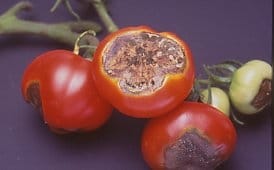Source(s): Willie O. Chance, UGA College of Agricultural and Environmental Sciences Extension Agent, Houston County.
Many home gardeners have been disappointed and frustrated when they picked that first ripe tomato and turned it over to find blossom-end rot.
Blossom end rot (BER) usually shows up first as a small dark or water soaked area on the bottom of the fruit. The spot can get larger until it covers the entire bottom half of the fruit or it may remain just a small spot. Affected fruit may begin to ripen earlier than other fruit. If the area gets larger it gets darker and sinks in. Blossom end rot is bad on tomatoes but it also affects peppers, eggplants and some melons.
Blossom end rot is caused by a calcium deficiency. Calcium is an essential nutrient for plants and for some reason; the tomato did not get enough calcium as it was growing.
Several things may cause BER. Calcium levels in the soil may be low. Since calcium moves into the plant with water, BER is worse in very wet or dry years. Other causes are poor rooting, improper watering, low soil pH, or using too much ammonia- containing fertilizer.
The main culprit is generally dry soils. It is especially important to keep plants well watered during early fruit development. Most of the calcium a tomato has enters the tomato fruit before it is the size of a quarter. During this early development, dry soils will cause BER, which shows up in the fruit near harvest time.
For these reasons, BER is better prevented than cured. Prevent it with these tips.
- Before planting, soil sample and lime to bring the pH up to 6.0. Add lime one to three months before planting.
- Add gypsum (calcium sulfate – one cup per plant or one to two pounds per 100 square feet) to the soil before planting. Gypsum works more quickly than lime to supply calcium to the plant. To find gypsum, call farm supply dealers or feed and seed and hardware stores.
- Plant in soils that are well drained and tilled at least eight to twelve inches deep.
- Water established plants with three-quarter inches of water twice a week. Do not waterlog plants or let them suffer from drought, especially early in the development of the tomato fruits. Water plants deeply and then let the soil dry slightly before watering again.
- Mulch around plants to keep the soil from drying out. Pull mulch slightly away from the main stem of the plant.
- Side dress tomatoes once every five weeks if necessary. Fertilizers can supply nitrogen in two forms – ammonium and nitrate. Use calcium nitrate, 5-10-15, 10-10-10 or similar fertilizers and look for fertilizers that have a higher percentage of nitrate nitrogen and lower levels of ammonium nitrogen. Read the fertilizer label to find this information. This is especially important when fruit are small. Try to wait until tomatoes are the size of a quarter before you side dress.
- Be careful when hoeing or cultivating. Damaged roots will not take up calcium well. Do not heavily prune tomatoes. This can make them more susceptible to BER.
- Once you have BER there is nothing you can do for affected fruits. Use these practices to prevent BER in new fruits. Often the first tomatoes are affected and later fruits are okay. In other words – the condition may get better as the plant matures.
- There are some calcium-containing sprays for BER. Sprays applied to the leaves do not control BER well because calcium usually enters the plant through the roots and should be applied to the soil. Calcium is not moved around in the plant well and may not make it into the fruit if we apply it to the leaves. If you want to treat affected plants with calcium, pour solutions of calcium chloride or the Blossom End Rot sprays around the tomato plant’s roots. The plant can take up calcium more readily this way.
- Another option is to sprinkle one-half cup of gypsum around the plant and water it in. Expect slower results using gypsum as compared to treating the soil with calcium chloride. If you cannot find gypsum – you can use lime but expect even slower results.
Blossom end rot is a disappointing beginning to the tomato harvest season. Fortunately, it is usually less of a problem as the year progresses. Use these tips to prevent this problem next year and to perhaps help the plants that you have now.
Resource(s): Vegetable Gardening in Georgia
Center Publication Number: 58
